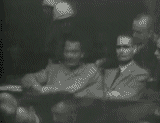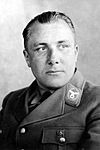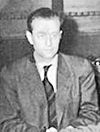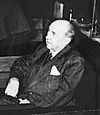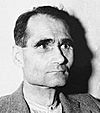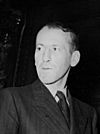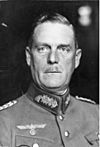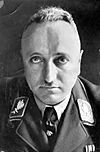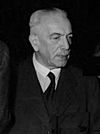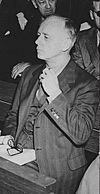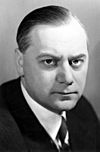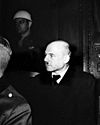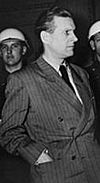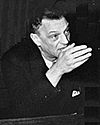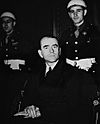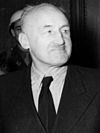Nuremberg Trials facts for kids
The Nuremberg Trials were a series of important court cases held after World War II. These trials aimed to bring justice to the leaders of Nazi Germany who had committed terrible crimes during the war.
There were two main parts to the Nuremberg Trials. The first and most famous part was the trial of the top Nazi leaders. This was handled by a special court called the International Military Tribunal (IMT). Judges and lawyers from four Allied countries – France, the Soviet Union, the United Kingdom, and the United States – worked together on this.
The second part involved 12 "follow-up trials." These trials focused on other important Nazis who were not the very top leaders, such as doctors and government officials. Even though these trials happened in the same courtroom, they were run only by the Americans. Originally, the plan was for the IMT to have more trials, and for each Allied country to hold its own trials for local officials. But because the Soviet Union and Western Allies had disagreements, the IMT only held one big trial. So, the United States decided to hold trials for the next most important Nazis themselves.
The Main Trial: Bringing Leaders to Justice
The main trial, led by the International Military Tribunal, started on October 18, 1945. It took place in the Supreme Court Building in Berlin. The first session was led by a Soviet judge named Nikitchenko.
The lawyers accused 24 major Nazi leaders and six Nazi organizations of serious wrongs. These organizations included the leadership of the Nazi Party, the Schutzstaffel (SS), the Sicherheitsdienst (SD), the Gestapo, the Sturmabteilung (SA), and the High Command of the German armed forces (OKW).
The charges against them were for:
- Working together to plan and commit serious wrongs against peace.
- Committing War crimes (actions that break the rules of war).
- Committing Crimes against humanity (terrible actions against large groups of people).
- Planning and starting aggressive wars.
Here are the 24 people who were accused:
"I" accused "G" accused and found guilty "O" Not Charged
| Name | Charge | Sentence | Notes | |||
|---|---|---|---|---|---|---|
| 1 | 2 | 3 | 4 | |||
|
|
I | O | G | G | Death | He took over from Hess as Nazi Party Secretary. He was sentenced to death even though he wasn't there. His body was found in 1972. |
|
|
I | G | G | O | 10 years | He led the German Navy (Kriegsmarine) from 1943. He started the U-boat attacks. He became President of Germany after Hitler died. He was found guilty of breaking a naval treaty, but his sentence wasn't based on how he used submarines. |
|
|
I | O | G | G | Death | He was the Nazi Law Leader and Governor-General of occupied Poland. He said he was sorry for his actions. |
|
|
I | G | G | G | Death | He was Hitler's Minister of the Interior and later a protector in Bohemia-Moravia. He helped write the Nuremberg Laws, which were anti-Jewish laws. |
|
|
I | I | I | O | Acquitted | He was a popular radio speaker and head of news for the Nazi Propaganda Ministry. He was tried instead of Joseph Goebbels. |
|
|
I | G | G | G | Life Imprisonment | He was Hitler's Minister of Economics and head of the German Central Bank (Reichsbank). He was released in 1957 because he was very sick. |
|
|
G | G | G | G | Death | He was the commander of the German Air Force (Luftwaffe) and a key Nazi leader. He died the night before he was supposed to be executed. |
| G | G | I | I | Life Imprisonment | He was Hitler's deputy. He flew to Scotland in 1941 to try to make peace. He was sent to Spandau Prison after the trial and died there in 1987. | |
|
Generaloberst Alfred Jodl
|
G | G | G | G | Death | He was a high-ranking military officer in the German armed forces (Wehrmacht). He was later cleared by a German court in 1953. |
|
|
I | O | G | G | Death | He was the highest-ranking SS leader who survived. He led the central Nazi intelligence office and commanded many special killing squads and concentration camps. |
|
|
G | G | G | G | Death | He was the head of the German armed forces (OKW). |
|
Gustav Krupp von Bohlen und Halbach
|
I | I | I | ---- | He was a major Nazi industrialist. He was too sick to be tried. His son, Alfried, was later tried in a separate Nuremberg trial for using slave labor. | |
|
|
I | I | I | I | ---- | He led the German Labour Front. He died on October 25, 1945, before his trial began. |
|
|
G | G | G | G | 15 years | He was the Minister of Foreign Affairs and later a protector in Bohemia and Moravia. He was released in 1954 due to poor health. |
|
|
I | I | O | O | Acquitted | He was Chancellor of Germany in 1932 and Vice-Chancellor under Hitler. He was found not guilty at Nuremberg but was later classified as a war criminal by a German court. |
| G | G | G | O | Life Imprisonment | He was the Commander-in-Chief of the German Navy (Kriegsmarine). He was released in 1955 because of ill health. | |
|
|
G | G | G | G | Death | He was the Minister of Foreign Affairs for Nazi Germany. |
|
Alfred Rosenberg
|
G | G | G | G | Death | He was a key Nazi thinker about racial theories. He later became Minister for the Eastern Occupied Territories. |
|
|
I | I | G | G | Death | He was in charge of the Nazi slave labor program. |
|
Dr. Hjalmar Schacht
|
I | I | O | O | Acquitted | He was a well-known banker and economist. He admitted breaking the Treaty of Versailles. |
|
Baldur von Schirach (standing)
|
I | O | O | G | 20 years | He was the head of the Hitler Youth and later a regional Nazi leader in Vienna. He expressed sorrow for his actions. |
|
|
I | G | G | G | Death | He helped with the "Anschluß" (joining Germany and Austria). He was later the Reich Commissioner of the occupied Netherlands. He also expressed sorrow. |
|
|
I | I | G | G | 20 Years | He was Hitler's favorite architect and Minister of Armaments. He used slave labor from occupied areas to make weapons. He expressed sorrow. |
|
|
I | O | O | G | Death | He was a Nazi leader who spread hatred and encouraged murder against Jewish people through his newspaper, Der Stürmer. |
"I" accused "G" accused and found guilty "O" Not Charged
The death sentences were carried out on October 16, 1946, by hanging. The French judges suggested using a firing squad for the military officers, which is common in military courts. However, the American and Soviet judges disagreed. They felt that these military officers had acted so badly that they did not deserve to be treated like regular soldiers. The prisoners who were sentenced to jail were moved to Spandau Prison in 1947.
The rules for what counts as a war crime are explained in the Nuremberg Principles. This document was created because of the trials. Also, the terrible medical experiments done by German doctors, which were tried in the Doctors' Trial, led to the creation of the Nuremberg Code. This code helps control how future research involving people is done.
Four organizations were accused of being criminal. Only the SS was found guilty. These organizations were found not to be criminal:
- Reichsregierung (the German government)
- Oberkommando and Generalstab der Wehrmacht (the High Command and General Staff of the Armed Forces)
- Sturmabteilung (the Stormtroopers or "Brownshirts")
| The Nuremberg Trials | ||||||||||||||||||||||||
| Trial of the Major War Criminals before the International Military Tribunal | ||||||||||||||||||||||||
| Trials before the U.S. Nuremberg Military Tribunals | ||||||||||||||||||||||||
|
Images for kids
-
Stalingrad in ruins, December 1942
-
Ruins of Nuremberg, around 1945
-
United States Army clerks with evidence
-
Hermann Göring under cross-examination
-
Telford Taylor opens for the lawyers in the Ministries trial, 6 January 1948
-
Monowitz prisoners unload cement from trains for IG Farben, shown as evidence
-
Germans read Süddeutsche Zeitung reporting the verdict, 1 October 1946
-
Benjamin Ferencz, chief lawyer of the Einsatzgruppen trial, in the Palace of Justice courtroom, 2012
See also
 In Spanish: Juicios de Núremberg para niños
In Spanish: Juicios de Núremberg para niños


